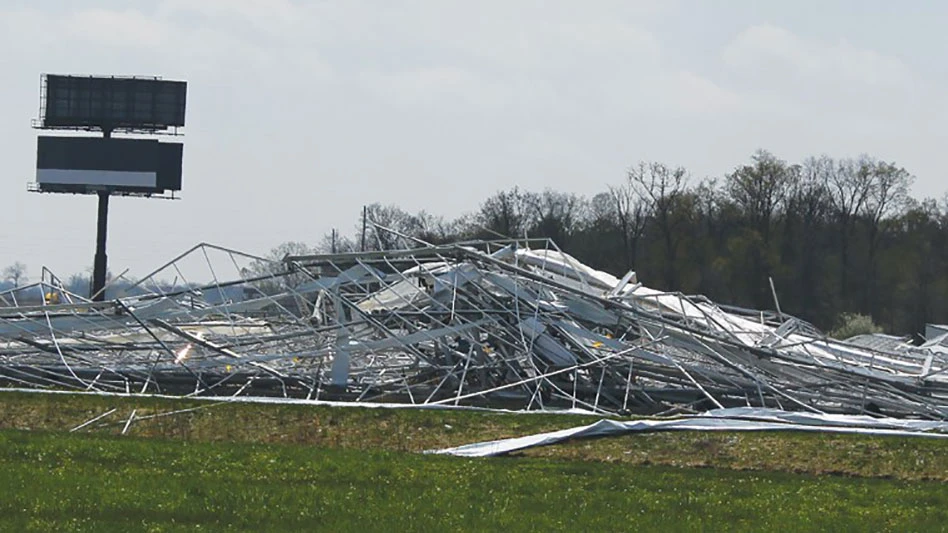

Editor’s note: This article originally ran as an e-GRO alert.
Emergencies due to severe weather, accidents and intentional malice can disrupt greenhouse operations in both the short and long term.
An early April storm with high winds, tornadoes and hail moved across the Midwest leaving a trail of destruction. This storm system completely flattened a 7-acre hydroponic greenhouse in Ohio, while also causing a hazardous materials spill consisting of fertilizer, nitric acid and bleach on the premises (Fig. 1).
Greenhouses in other regions of the United States may experience natural disasters such as excessive snow loads, aerial flooding, hail, hurricanes, wildfires, earthquakes, tornados, as well as unfortunate accidents. Any of these events can lead to damaged or destroyed structures and equipment, loss of plant material, and injured employees.
Here are just a few examples of emergencies greenhouse businesses have faced in the past:
- Structural failure due to straight line winds or heavy snow loads
- Fire in storage structures or supply rooms
- Microbial contamination leading to food-borne illnesses from edible crops
- Chemical, fertilizer and/or pesticide spills
- Damage to crops following extreme temperatures, system failures or during transport
How prepared are you and your employees to respond to an emergency? While not every emergency can be prevented, you can develop policies and plans to alleviate some of the adverse effects of natural disasters and accidents before and after they happen. This is called an emergency action plan (EAP).
Consider these strategies to help you better prepare for when an emergency occurs.
Emergency Response Team
Who are the key players in your operation that need to be involved in developing your emergency response plan? Choose individuals that understand your facilities and how your business operates such as maintenance employees, growers, and those involved in employee management and transportation of goods. Invite these folks to help develop and implement a sound plan.
Facilities Review
Evaluate facilities annually. Are there items in need of repair or replacement? Determine which items or necessary changes are most urgent and will have the greatest potential impact on overall safety.
Is there a current map of the operation identifying storm shelters, fire extinguishers, pesticide and chemical storage areas, emergency exits, etc. Are all employees familiar with the location of these items? Have you performed a drill or mock event, so all employees are aware of how to handle a variety of emergency situations? Involve local first responders in your EAP development and drills.

Insurance
Evaluate your present insurance coverage. If you do not have insurance coverage, speak with a local agency or one specifically dealing with agricultural businesses. A detailed analysis of your needs and coverage amounts provides peace of mind as well as financial security if an accident or disaster occurs.
Emergency Contacts
Who needs to be notified in the event of an emergency? A list of key personnel and others should be compiled and shared with all employees.
Include supervisors, company leaders and local first responders. How will you communicate with employees and others in the event phones lines are down or electricity is out?
Additional resources to review and implement include:
- UMass Extension Storm Preparedness and Response: bit.ly/umass-storm-response
- OSHA’s Emergency Preparedness for Farmworkers (Fig. 2): bit.ly/osha-emergency-checklist

Explore the December 2023 Issue
Check out more from this issue and find your next story to read.
Latest from Greenhouse Management
- Growing enlightened
- American Floral Endowment awards 17 organizations $60,700 in educational grants
- Floral businesses invited to join Society of American Florists' Petal It Forward event in October
- Bioline AgroSciences acquires Viridaxis to strengthen leadership in aphids biocontrol
- Ryley Leech joins JumpLights as vice president of sales
- Meet the Retailers' Choice Awards from 2025 Farwest Show
- Added value
- National Garden Bureau announces featured crops for 2026 'Year of the' program






